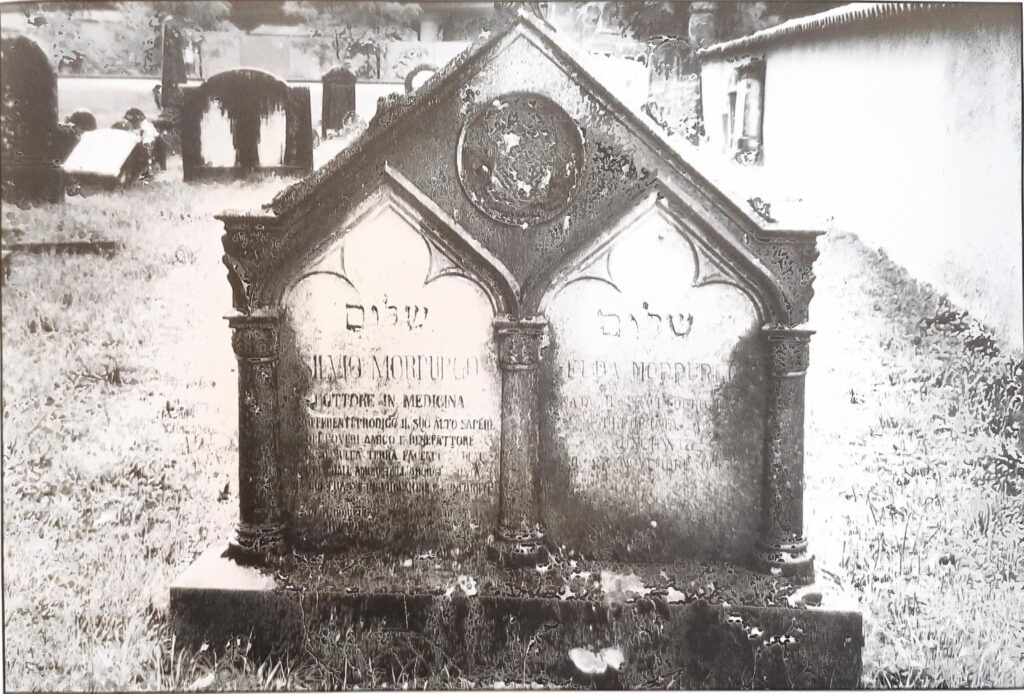Learn More

In Gorizia the Jewish Community had previously used an existing burial place which dated back to the eighteenth century, located where the current Synagogue stands.
The Cemetery of Valdirose or Rožna Dolina was used from 1829, when sixteen stones were transferred there from the ancient cemetery and other places, including a star dating back to 1371 from Maribor, along with others from Cormons and Trieste.
From 1947 the Cemetery became part of Yugoslavian territory and was no longer used by the Jews of Gorizia, who from that point were buried in the Cemetery in Gradisca.
There are more than 900 tombs in Rožna Dolina, as well as a chapel which was used for funeral services.
The headstones face towards Jerusalem, and instead of flowers there are stones to show the remembrance of the living. There are upright tombstones (typically Ashkenazi) most often with only Hebrew characters (on the oldest stones). There are also shorter inscriptions in other languages, including Italian and German. The symbols are the same as we find in other cemeteries: family crests with simple symbols (the cedar tree, crowns, acanthus leaves, pomegranates, lamps, a palm branch). Overall, the headstones are very simple and there are no monumental tombs.
The oldest stone legible today dates back to 1653 and belongs to Grassin Gentilli di Raffaele Haver.
There are six ancient epigraphs, which are from between 1406 and1652; stones dedicated to soldiers who died during the First World War; and others to remember those murdered in Nazi camps.
Buried here are the doctors Silvio Morpurgo and Vittorio Pavia, who were held in high regard by their fellow citizens, and who were willing to treat needy patients for free. They died shortly after the racial laws were announced in 1938 – laws which prohibited them from practicing their beloved profession. Elda Morpurgo, nee Michelstaedter, sister of the philosopher and wife of the medic Silvio, was deported from Gorizia on 23 November 1943. She is remembered with a headstone that stands next to her husband’s.
Other people buried here include: Oscar Morpurgo (head of the civil hospitals in the 1800s – he was devoted to the Jewish Community, and financed the creation of the war around the Cemetery), the journalist Carolina Coen Luzzatto, the Michelstaedter family, Rabbi Isacco Samuele Reggio, Rabbi Abramo Vita Reggio and Rabbi Giacomo Bolaffio. Also notable is the shopkeeper Benedetto Morpurgo, who led a protest against the clergy for spreading accusations of ritual murder.
Carlo Michelstaedter and Ada Coen Luzzatto (daughter of the journalist Carolina) do not have headstones as they are suicides, just a little stone to commemorate them.
In the cemetery of Valdirose three members of the Austro-Hungarian army are buried: Lieutenant Chaim Huppert, Dr Eduard Auersach and Dr Fritz Hochwald. The soldier Franz Artner is also buried here, having been moved from the military cemetery of Chiapovano in 1929.
SOURCES:
Agostino Colla and Maria Elisabetta Loricchio (eds), Beth Ha Chajim: la Casa dei Viventi. Valdirose. Il cimitero della Comunità ebraica di Gorizia, Edizioni della Laguna, 2004
Marcello Morpurgo, Valdirose. Memorie della Comunità ebraica di Gorizia, Del Bianco, Udine 1986
D. Ogrin, Il cimitero ebraico di Nova Gorica importante monumento di cultura funeraria, in “Srecanja”, XXV (1972)
Angelo Vivian, Il cimitero israelitico di Nova Gorica, in Ioly Zorattini Pier Cesare (ed.), Gli ebrei a Gorizia e a Trieste tra “ancien régime” ed emancipazione, Del Bianco, Udine 1984, pp. 91-97
Translation from Italian to English by Bethany Gaunt
Project by
Jewish Community of Trieste and Ca’ Foscari University Venezia
Info
visit@triestebraica.it
